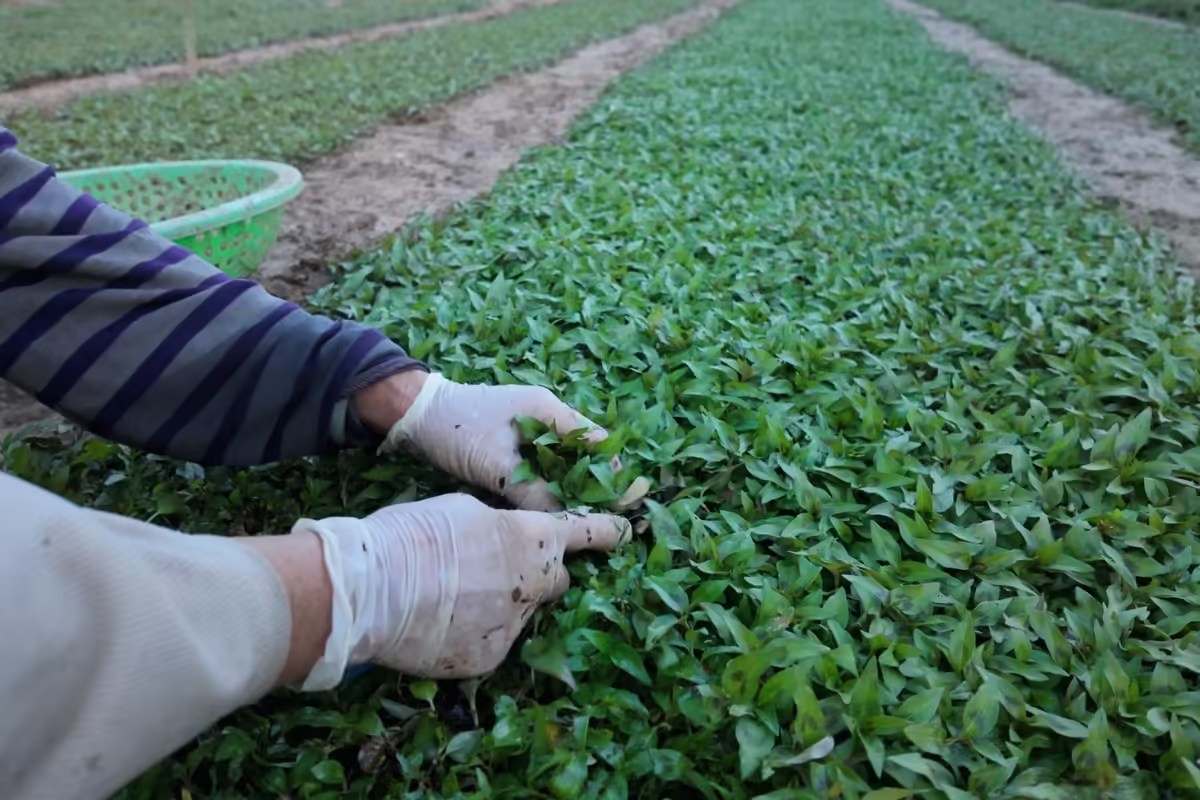
Vietnamese Coriander: All You Need to Know About This Herb
Vietnamese coriander is a familiar herb in Vietnam, often used to add a bright, herbal note to some traditional dishes. In this article, we’ll explore its characteristics, how it’s grown, and the flavorful ways it enhances Vietnamese cuisine.
What is Vietnamese coriander?
Overview

Vietnamese coriander plants thriving and ready for harvest in a home garden.
Characteristics of Vietnamese coriander
Leaves
Vietnamese coriander leaves are elongated and smooth, typically measuring 5 to 8 cm in length and about 2 cm in width. The leaf surface is glossy, with a vibrant dark green color and occasional brown spots on the top side. The underside often has a subtle reddish-purple hue. The leaf edges are smooth, and the overall shape tapers gently to a pointed tip.

Close-up of fresh Vietnamese coriander leaves

Underside of Vietnamese coriander leaves

The width of a Vietnamese coriander leaf

The length of a Vietnamese coriander leaf
Stems
The stems of Vietnamese coriander are soft and slender, with short, distinct nodes. They typically have a reddish-purple tint. Under favorable conditions, the plant can grow up to 30 cm tall and spread outward, forming a dense, leafy ground cover.

Close-up of Vietnamese coriander stems
Aroma and flavor
Unlike other popular Vietnamese herbs such as Thai basil, perilla, or piper lolot, Vietnamese coriander doesn’t have an immediately strong aroma. But if you simply taste a fresh leaf, you’ll notice bright citrusy and minty notes, followed by a slightly spicy aftertaste that gently lingers on the tongue.
Growing and harvesting Vietnamese coriander
Ideal conditions for growing Vietnamese coriander
Vietnamese coriander is incredibly easy to grow—it even grows wild in many parts of Vietnam. However, for the healthiest and most flavorful leaves, there are a few important growing conditions to keep in mind.
In Vietnam, farmers typically grow Vietnamese coriander either from seeds or, more commonly through stem cuttings. This simple, low-effort method involves selecting healthy stems about 10 to 15 centimeters long, then planting them directly into moist, fertile soil. With regular care, the cuttings quickly develop roots and grow into lush, vibrant plants, ready for harvest in just a few weeks.

Vietnamese coriander plants thriving in a home garden.

Close-up of fertile soil used for growing Vietnamese coriander.
Harvesting Vietnamese coriander
Vietnamese coriander grows quickly and can be harvested just 40 days after planting. Here’s how farmers in Vietnam typically harvest it for continuous growth:

Close-up of a Vietnamese farmer harvesting Vietnamese coriander by hand.

Vietnamese coriander plants after harvesting, with trimmed stems ready for regrowth
How to use Vietnamese coriander in cooking
Vietnamese coriander is a versatile ingredient that can be incorporated into a wide range of dishes, adding depth and complexity to flavors. Here are some ways to incorporate this herb into your culinary creations:
Vietnamese coriander in traditional Vietnamese cuisine
Vietnamese coriander is often used to add a gentle herbal note to various Vietnamese dishes. Here are some common ways it appears in local cuisine:
Vietnamese chicken salad (goi ga)
Vietnamese chicken salad often features Vietnamese coriander leaves, along with other components such as onions, cilantro, lime, and chili peppers, creating a harmonious blend of flavors.
Beef and tomato soup with Vietnamese coriander (canh ca chua thit bo)
This is a beloved Vietnamese soup that features beef and tomatoes as the main ingredients. Once the soup is cooked, the chef sprinkles fresh Vietnamese coriander leaves on top to add a unique and delightful flavor.

A comforting bowl of Vietnamese beef and tomato soup, garnished with Vietnamese coriander.
Soup with crucian carp and Vietnamese coriander (canh ca giec rau ram)
In this delicious soup, fresh crucian carp is first cleaned and marinated with a blend of onions, salt, fish sauce, and fresh chili peppers. The chef then brings a pot of water to a boil, adds the marinated fish, and lets it cook until the water boils again. Finally, Vietnamese coriander is added to the pot, infusing the soup with its distinctive and aromatic flavor.
Fertilized duck eggs (hot vit lon)
Fertilized duck eggs, also known as hot vit lon, are a popular street food in Vietnam. These eggs are boiled until fully cooked, and the inside contains a partially developed duck embryo. To enjoy this delicacy, Vietnamese people crack open the shell and eat the contents, often accompanied by Vietnamese coriander and a sprinkle of salt and pepper.

Fertilized duck eggs served with fresh coriander and tangy pickled veggies.
In Vietnamese culture, there’s a long-held belief that consuming Vietnamese coriander may help reduce sexual desire; however, this is more of a cultural belief than a scientifically proven fact.



Leave a Reply